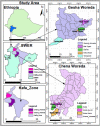Evaluation of breeding objectives, breeding practices and reproductive performance of indigenous dairy cows in selected districts of Kaffa Zone, South West Ethiopia
- PMID: 37728180
- PMCID: PMC10650342
- DOI: 10.1002/vms3.1267
Evaluation of breeding objectives, breeding practices and reproductive performance of indigenous dairy cows in selected districts of Kaffa Zone, South West Ethiopia
Abstract
Background: Breeding objectives are designed to achieve targeted dairy cow production goals, which can be affected by production type, farmer preferences, environmental factors and genetic factors individually or in combination. Breeding practices, such as both controlled and uncontrolled, and artificial insemination (AI) are the tools used to obtain the desired breeding objectives. The lower reproductive performance of indigenous dairy cows affects the total milk production and calf crops that are produced during their lifetime. Designing appropriate breeding objectives and breeding practices can improve the reproductive performance of dairy cows and their overall production performance.
Materials and methods: The current study was conducted with the objective of evaluating the breeding, practices and performance of indigenous dairy cattle in the south western part of Ethiopia. The districts of Gesha and Chena were purposefully chosen. The study design for the 384 household surveys was a cross-sectional survey with a simple random sample approach. Data analysis was carried out by MS-Excel (2010) and the general linear model procedure of SAS of 2008.
Results: The current study revealed that methods of breeding were predominantly natural-controlled mating, followed by natural-uncontrolled mating and AI in descending order. Breeding objectives were input function, output function, sociocultural and economic functions and assets and security functions in decreasing order of rank. Reproduction performance indexes of indigenous dairy cows age at first service (3.72 ± 0.05 years), age at first calving (AFC) (4.71 ± 0.07 years), calving interval (CI) (1.58 ± 0.03 years), days open (DO) (4.26 ± 0.11 months), services per conception in natural mating (1.4 ± 0.08) and AI (2.73 ± 0.14), age of bull at maturity (4.17 ± 0.74 years), interoestrus interval (23.18 ± 0.61 days), calves crop (7.53 ± 0.22) and the life span of indigenous dairy cow (11.94 ± 0.26 years) were significant (p < 0.01) between two districts, whereas the values of age of bull at maturity and number of services per conception in natural mating were significant (p < 0.05) between districts.
Conclusions: Using AI and major reproduction performances, such as AFC, CI and DO of indigenous dairy cows in the study area, were very low. Therefore, concerned bodies should intervene to improve reproduction performance through the utilization of AI techniques, with the integration of forage development activities and improvements in livestock health care.
Keywords: age at first calving; artificial insemination; calving interval; cattle; natural mating.
© 2023 The Authors. Veterinary Medicine and Science published by John Wiley & Sons Ltd.
Conflict of interest statement
The authors declare no conflicts of interest.
Similar articles
-
Success rate of artificial insemination, reproductive performance and economic impact of failure of first service insemination: a retrospective study.BMC Vet Res. 2022 Jun 14;18(1):226. doi: 10.1186/s12917-022-03325-1. BMC Vet Res. 2022. PMID: 35701792 Free PMC article.
-
Comparison of reproductive performance by artificial insemination versus natural service sires in California dairies.Theriogenology. 2005 Aug;64(3):603-13. doi: 10.1016/j.theriogenology.2005.05.030. Theriogenology. 2005. PMID: 15963557
-
Multi-country investigation of factors influencing breeding decisions by smallholder dairy farmers in sub-Saharan Africa.Trop Anim Health Prod. 2019 Feb;51(2):395-409. doi: 10.1007/s11250-018-1703-7. Epub 2018 Sep 12. Trop Anim Health Prod. 2019. PMID: 30206807 Free PMC article.
-
Epidemiology of reproductive performance in dairy cows.Anim Reprod Sci. 2000 Jul 2;60-61:605-14. doi: 10.1016/s0378-4320(00)00085-3. Anim Reprod Sci. 2000. PMID: 10844228 Review.
-
Heifer fertility and carry over consequences for life time production in dairy and beef cattle.Animal. 2014 May;8 Suppl 1:91-104. doi: 10.1017/S1751731114000755. Epub 2014 Apr 3. Animal. 2014. PMID: 24698359 Review.
Cited by
-
Spatiotemporal analysis and forecasting of lumpy skin disease outbreaks in Ethiopia based on retrospective outbreak reports.Front Vet Sci. 2024 Mar 12;11:1277007. doi: 10.3389/fvets.2024.1277007. eCollection 2024. Front Vet Sci. 2024. PMID: 38532795 Free PMC article.
-
Smallholder farmers' participation in small-scale irrigation system: Insight from Lume district, Ethiopia.Heliyon. 2024 Oct 19;10(20):e39638. doi: 10.1016/j.heliyon.2024.e39638. eCollection 2024 Oct 30. Heliyon. 2024. PMID: 39497973 Free PMC article.
-
Long-Term Body Weight Trends in Gobra Zebu Cattle Reared at the 'Centre de Recherches Zootechniques' of Dahra (Senegal): A Historical Perspective (1952-2018).Vet Med Sci. 2025 Jan;11(1):e70136. doi: 10.1002/vms3.70136. Vet Med Sci. 2025. PMID: 39601274 Free PMC article.
References
-
- Abebe, M. , Tassew, A. , & Asmare, B. (2021). Appraisal of milk production, processing and marketing in selected urban and peri‐urban dairy production systems of northwestern Ethiopia. Scientific Papers: Animal Science and Biotechnologies/Lucrari Stiintifice: Zootehnie si Biotehnologii, 54(1), 204–220.
-
- Adisu, A. , & Zewdu, W. (2021). Cause for the occurrence of freemartin and its influence on livestock reproductive performance: A review. Journal of Animal Health and Behavioral Science, 5, 105.
-
- Agere, M. , Haile, A. , Dessie, T. , & Mekasha, Y. (2012). On farm characterization of Horro cattle breed production systems in western Oromia, Ethiopia. Livestock Research for Rural Development, 24, 6–17.
-
- Amanuel, M. (2019). Evaluation of efficiency of estrus synchronization and assessment of breeding practice of dairy cattle in Jimma zone, south western Ethiopia . A MSc. Thesis submitted to Jimma University in Animal Breeding and Genetics.
-
- Anwar, M. , Cain, P. J. , Hhan, M. S. , Abdullah, M. , & Babar, M. E. (2009). Factors affecting the shape of the lactation curvde in Nill‐Ravi Buffaloes in Pakistan. Pakistan Journal of Zoology, 9, 201–207.
MeSH terms
LinkOut - more resources
Full Text Sources


